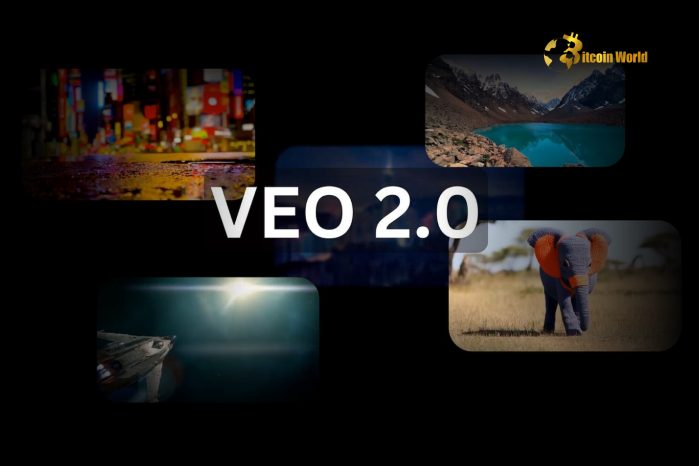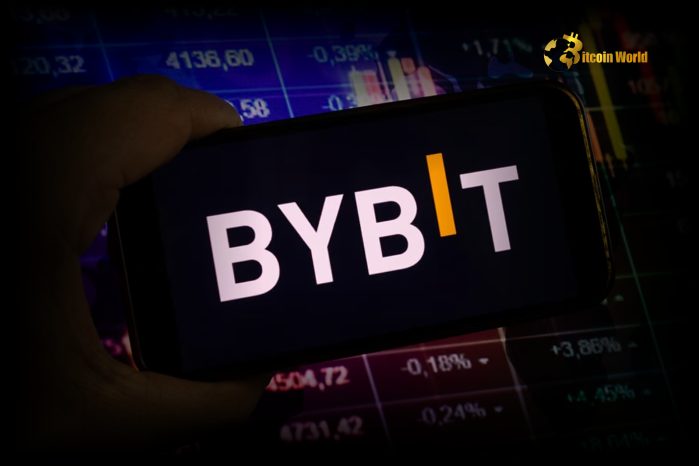
Bitcoin price failed to gain pace for a move above the $100,000 zone. BTC again declined and is currently consolidating near the $96,000 zone. Bitcoin started a fresh decline from the $99,500 zone. The price is trading below $97,500 and the 100 hourly Simple moving average. There is a connecting bearish trend line forming with resistance at $96,400 on the hourly chart of the BTC/USD pair (data feed from Kraken). The pair could start another increase if it stays above the $95,000 zone. Bitcoin Price Dips Again Bitcoin price formed a base above the $95,500 level and started a recovery wave . BTC was able to surpass the $97,000 and $98,500 resistance levels. The price even cleared the $99,000 resistance level. However, the bears remained active below the $100,000 level. A high was formed at $99,481 and the price started a fresh decline. There was a move below the $98,000 and $96,000 levels. A low was formed at $94,888 and the price is now recovering. There was a move above the $95,500 level. The price surpassed the 23.6% Fib retracement level of the downward move from the $99,481 swing high to the $94,881 low. Bitcoin price is now trading below $97,200 and the 100 hourly Simple moving average . On the upside, immediate resistance is near the $96,500 level. There is also a connecting bearish trend line forming with resistance at $96,400 on the hourly chart of the BTC/USD pair. The first key resistance is near the $97,200 level or the 50% Fib retracement level of the downward move from the $99,481 swing high to the $94,881 low. The next key resistance could be $97,750. A close above the $97,750 resistance might send the price further higher. In the stated case, the price could rise and test the $98,800 resistance level. Any more gains might send the price toward the $99,500 level or even $100,000. Another Decline In BTC? If Bitcoin fails to rise above the $97,200 resistance zone, it could start a fresh decline. Immediate support on the downside is near the $95,500 level. The first major support is near the $95,000 level. The next support is now near the $94,200 zone. Any more losses might send the price toward the $93,500 support in the near term. The main support sits at $92,400. Technical indicators: Hourly MACD – The MACD is now gaining pace in the bullish zone. Hourly RSI (Relative Strength Index) – The RSI for BTC/USD is now above the 50 level. Major Support Levels – $95,500, followed by $95,000. Major Resistance Levels – $96,500 and $97,200.
NewsBTC
You can visit the page to read the article.
Source: NewsBTC
Disclaimer: The opinion expressed here is not investment advice – it is provided for informational purposes only. It does not necessarily reflect the opinion of BitMaden. Every investment and all trading involves risk, so you should always perform your own research prior to making decisions. We do not recommend investing money you cannot afford to lose.
Shocking Veo 2 Pricing Revealed: Google’s AI Video Costs $0.50/Second

Hold onto your hats, crypto enthusiasts and AI aficionados! Google has just dropped a bombshell about the highly anticipated Veo 2, their cutting-edge AI video model pricing . We finally know how much this powerhouse of video generation will set you back, and the numbers are… well, let’s just say they’re generating a lot of buzz. Is this the dawn of democratized video creation, or are we looking at a premium tool for the elite? Let’s dive into the details of the Google Veo 2 cost and see what it means for the future of content creation. Decoding the Veo 2 Pricing: What Does 50 Cents Per Second Mean? Google has quietly updated its pricing page, revealing that Veo 2 will operate on a pay-as-you-go model, charging 50 cents for every second of video generated. At first glance, this might seem like pocket change, but let’s break down what this AI video generation cost actually translates to: Per Minute: 50 cents/second * 60 seconds = $30 per minute Per Hour: $30/minute * 60 minutes = $1,800 per hour Suddenly, that 50 cents per second starts to look a bit more substantial. While it’s not going to bankrupt a major corporation, it definitely puts Veo 2 in a different category than some might have expected. Google DeepMind researcher Jon Barron even drew a comparison to the colossal budget of “Avengers: Endgame,” highlighting the vast difference in cost per second between a Hollywood blockbuster and AI-generated video – but is this a fair comparison? Let’s explore further. Veo 2 vs. Hollywood Budgets: Apples and Oranges? Barron’s comparison to “Avengers: Endgame,” with its reported $32,000 per second production cost, is certainly attention-grabbing. However, it’s crucial to understand that we’re comparing vastly different things. “Avengers: Endgame” involved: Massive crews and casts: Hundreds, if not thousands, of people working for months. Physical sets and locations: Building sets, securing locations, and managing logistics. Practical effects and CGI: A blend of real-world effects and computer-generated imagery. Extensive post-production: Editing, sound design, visual effects refinement, and more. Veo 2, on the other hand, is software. The AI video model pricing reflects the computational power, development costs, and ongoing maintenance of this complex technology. It’s a tool, not an entire production studio. While Veo 2 might not (yet) be capable of producing a feature-length film, its strength lies in rapid, on-demand video creation for various applications. How Does Veo 2’s Cost Compare to Competitors Like Sora? The elephant in the room is OpenAI’s Sora. While Sora’s pricing model isn’t directly comparable, it’s important to consider the competitive landscape. Currently, Sora is available to ChatGPT Pro subscribers who pay $200 per month. This subscription model offers a different value proposition. Let’s compare the two approaches: Feature Veo 2 (Pay-per-second) Sora (Subscription via ChatGPT Pro) Pricing Model $0.50 per second of video $200/month for ChatGPT Pro access Cost for 1 Minute Video $30 Potentially lower if generating many videos per month Cost for 1 Hour Video $1,800 Still $200/month subscription cost Accessibility Directly accessible (presumably) Requires ChatGPT Pro subscription Best Suited For Projects with variable video needs, where cost scales with usage. Users who anticipate frequent video generation within a month. The choice between Veo 2 and Sora (or other affordable AI video options as they emerge) will depend heavily on your specific needs and usage patterns. If you need short clips sporadically, Veo 2’s pay-per-second model might be efficient. However, for users generating videos regularly, a subscription model like Sora’s could prove more cost-effective in the long run. Is Veo 2’s Pricing a Game Changer or a Barrier? The Veo 2 pricing structure is undoubtedly a significant factor in its potential adoption. Let’s consider the potential impacts: For Professional Creators: For marketing agencies, news outlets, and businesses needing video content, Veo 2 could be a powerful tool, especially for supplementing existing video production workflows. The cost, while not insignificant, might be justifiable for specific projects. For Independent Creators and Hobbyists: The price point might be a barrier for casual users or independent creators on a tight budget. However, for specific projects where high-quality AI video is crucial, it could still be a viable option. Impact on the AI Video Market: Veo 2’s pricing sets a benchmark in the nascent AI video generation market. It signals that high-quality AI video generation is not yet a commodity and reflects the substantial resources required to develop and operate these models. Ultimately, whether Veo 2’s pricing is a game-changer or a barrier depends on your perspective and needs. It’s not designed to be a free or extremely cheap tool, but rather a professional-grade solution for specific applications. As AI video model pricing evolves and competition increases, we can expect to see a wider range of options emerge, catering to different budgets and use cases. Actionable Insights: Navigating the World of AI Video Costs So, what should you do with this information? Here are some actionable insights: Assess Your Video Needs: Before jumping into AI video generation, carefully evaluate your video requirements. How much video do you need? What level of quality is required? What is your budget? Compare Pricing Models: Don’t just look at Veo 2. Explore other AI video generation platforms and their pricing structures. Compare pay-per-second, subscription, and credit-based models to find the best fit for your needs. Start Small and Experiment: If you’re unsure, start with smaller projects and shorter videos to test the waters. Experiment with different AI video tools to see which ones deliver the best results for your specific use cases. Factor in Post-Production: Remember that AI-generated video might still require editing, sound design, and other post-production work. Factor these costs into your overall budget. Stay Updated on AI Video Trends: The AI video landscape is rapidly evolving. Keep an eye on new models, pricing changes, and emerging best practices to make informed decisions. The Future of AI Video: Premium or Accessible to All? Google’s Veo 2 pricing announcement is a significant moment in the development of affordable AI video technology. It highlights the current realities of developing and deploying advanced AI models. While the 50 cents per second cost might seem steep to some, it’s crucial to remember that this is still early days for truly high-quality, versatile AI video generation. As technology advances and becomes more efficient, and as competition heats up, we can anticipate a future where AI video generation cost becomes more accessible and democratized. For now, Veo 2 represents a powerful, albeit premium, tool in the evolving landscape of AI-driven content creation. To learn more about the latest AI market trends, explore our article on key developments shaping AI features. NewsBTC

SafeWallet Returns: Services Resume with Enhanced Security After Bybit Hack
Great news for Safe{Wallet} users! After a brief period of uncertainty, the popular Ethereum multi-sig wallet is gearing up to relaunch its services. In an exciting announcement made on X just an hour ago, Safe{Wallet} confirmed that it will be initiating a phased rollout of services within the next 24 hours. This eagerly awaited return comes with a significant upgrade: enhanced security measures designed to provide users with an even more robust and reliable crypto wallet experience. This development follows a temporary suspension of certain functionalities, a precautionary step taken after a hacking incident impacted the crypto exchange Bybit. Let’s dive into what this means for Safe{Wallet} users and the broader crypto community. Why is SafeWallet Resuming Services with Enhanced Security? The temporary suspension of certain Safe{Wallet} functionalities was a proactive measure in response to a security breach at Bybit. While Safe{Wallet} itself was not directly compromised, the team took swift action to ensure the platform remained secure for all users. This temporary pause allowed them to conduct thorough security audits and implement additional layers of protection. The upcoming resumption of services signifies that Safe{Wallet} has successfully fortified its platform and is now ready to welcome users back with even stronger defenses against potential threats. This proactive approach underscores Safe{Wallet}’s commitment to user safety and the integrity of its crypto wallet services. What Enhanced Security Measures are Being Implemented in SafeWallet? While specific details of the enhanced security measures are yet to be fully disclosed, Safe{Wallet} has assured its community that significant upgrades have been implemented. We can anticipate these enhancements to focus on strengthening the platform’s resilience against various attack vectors. Here are some potential areas of improvement based on industry best practices: Advanced Threat Detection: Implementing more sophisticated systems to identify and neutralize potential threats in real-time. Multi-Factor Authentication (MFA) Enhancements: Strengthening MFA protocols to add extra layers of verification beyond passwords. Smart Contract Audits: Conducting even more rigorous and frequent audits of their smart contracts to identify and patch vulnerabilities. Infrastructure Upgrades: Improving the underlying infrastructure to enhance its robustness and security. Collaboration with Security Experts: Working closely with leading cybersecurity firms to continuously monitor and improve their security posture. These measures are crucial in today’s evolving crypto landscape, where security is paramount. Safe{Wallet}’s dedication to enhancing its defenses demonstrates a proactive approach to safeguarding user assets. When Can You Access Your SafeWallet and Utilize its Features? The announcement of a phased rollout within the next 24 hours is incredibly encouraging for Safe{Wallet} users. A phased rollout typically means that access to services will be gradually restored to different user segments over the specified period. This approach allows Safe{Wallet} to monitor the system closely as it comes back online and address any unforeseen issues in a controlled manner. Here’s what you can expect in the phased rollout: Phase Timeline Expected Actions Phase 1 Within the first few hours Initial system checks and activation of core functionalities for a limited group of users. Monitoring for stability. Phase 2 Next 12-18 hours Gradual expansion of access to a larger user base. Full functionality testing and performance evaluation. Phase 3 Within 24 hours General availability of all Safe{Wallet} services to all users. Comprehensive system monitoring and ongoing security assessments. It’s advisable to keep an eye on Safe{Wallet}’s official X (formerly Twitter) account and other communication channels for real-time updates on the rollout progress. This phased approach is designed to ensure a smooth and secure return to full functionality for every SafeWallet user. Why Choose SafeWallet as Your Multi-Sig Wallet? Safe{Wallet} is renowned for its robust multi-sig wallet functionality, particularly within the Ethereum ecosystem. Multi-signature wallets offer a significant advantage over single-signature wallets by requiring multiple private keys to authorize transactions. This dramatically enhances security and reduces the risk of unauthorized access or single points of failure. Key benefits of using a multi-sig wallet like SafeWallet: Enhanced Security: Multi-signature requirement makes it significantly harder for hackers to compromise funds. Even if one key is compromised, the attacker still needs access to other keys to move assets. Protection Against Key Loss: In scenarios where one key holder loses access to their key, funds are not lost as long as the other key holders are still accessible. Organizational Security: Ideal for teams, DAOs, and organizations managing crypto assets, as it ensures that no single individual has unilateral control over funds. Transparency and Accountability: Multi-sig transactions provide greater transparency and accountability, as all transactions require agreement from multiple parties. Safe{Wallet}’s commitment to security , combined with the inherent advantages of multi-sig technology, positions it as a leading choice for users seeking a secure and reliable way to manage their Ethereum and other crypto assets. Navigating the Challenges: Security in the Crypto Wallet Space The recent incident, although not directly targeting Safe{Wallet}, highlights the ongoing challenges and importance of security in the cryptocurrency space. Crypto wallets, as custodians of digital assets, are prime targets for malicious actors. The crypto industry is constantly battling evolving threats, requiring continuous innovation and vigilance in security practices. Challenges in crypto wallet security include: Sophisticated Hacking Techniques: Hackers are becoming increasingly sophisticated, employing advanced phishing, social engineering, and technical exploits. Smart Contract Vulnerabilities: While smart contracts enable innovation, they can also contain vulnerabilities that can be exploited if not rigorously audited. User Error: Users themselves can sometimes be the weakest link, falling victim to scams or not adequately securing their private keys. Regulatory Uncertainty: The evolving regulatory landscape can sometimes create challenges for crypto wallet providers in implementing consistent and compliant security measures. Addressing these challenges requires a multi-faceted approach, including robust technology, user education, industry collaboration, and proactive adaptation to the ever-changing threat environment. Safe{Wallet}’s response to the Bybit incident and its commitment to enhanced security demonstrate a responsible and proactive approach to these ongoing challenges. Conclusion: A Stronger and Safer SafeWallet is on the Horizon The news of Safe{Wallet} resuming services with enhanced security is a significant positive development for the crypto community. It underscores the resilience of the ecosystem and the commitment of platforms like Safe{Wallet} to prioritize user safety above all else. The temporary suspension, while inconvenient, was a necessary step to reinforce security measures and ensure a more robust and trustworthy platform going forward. As Safe{Wallet} embarks on its phased rollout, users can look forward to returning to a platform that is not only feature-rich and user-friendly but also fortified with cutting-edge security enhancements. This return signals a stronger, safer, and more reliable Safe{Wallet} experience for everyone. To learn more about the latest crypto wallet security trends, explore our article on key developments shaping crypto wallet security best practices. NewsBTC











